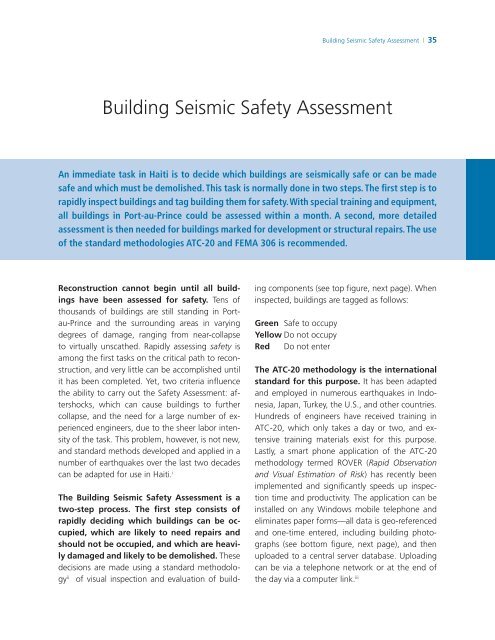Haiti Earthquake Reconstruction Knowledge Notes from ... - GFDRR
Haiti Earthquake Reconstruction Knowledge Notes from ... - GFDRR
Haiti Earthquake Reconstruction Knowledge Notes from ... - GFDRR
You also want an ePaper? Increase the reach of your titles
YUMPU automatically turns print PDFs into web optimized ePapers that Google loves.
Building Seismic Safety Assessment | 35<br />
Building Seismic Safety Assessment<br />
An immediate task in <strong>Haiti</strong> is to decide which buildings are seismically safe or can be made<br />
safe and which must be demolished. This task is normally done in two steps. The first step is to<br />
rapidly inspect buildings and tag building them for safety. With special training and equipment,<br />
all buildings in Port-au-Prince could be assessed within a month. A second, more detailed<br />
assessment is then needed for buildings marked for development or structural repairs. The use<br />
of the standard methodologies ATC-20 and FEMA 306 is recommended.<br />
<strong>Reconstruction</strong> cannot begin until all buildings<br />
have been assessed for safety. Tens of<br />
thousands of buildings are still standing in Portau-Prince<br />
and the surrounding areas in varying<br />
degrees of damage, ranging <strong>from</strong> near-collapse<br />
to virtually unscathed. Rapidly assessing safety is<br />
among the first tasks on the critical path to reconstruction,<br />
and very little can be accomplished until<br />
it has been completed. Yet, two criteria influence<br />
the ability to carry out the Safety Assessment: aftershocks,<br />
which can cause buildings to further<br />
collapse, and the need for a large number of experienced<br />
engineers, due to the sheer labor intensity<br />
of the task. This problem, however, is not new,<br />
and standard methods developed and applied in a<br />
number of earthquakes over the last two decades<br />
can be adapted for use in <strong>Haiti</strong>. i<br />
The Building Seismic Safety Assessment is a<br />
two-step process. The first step consists of<br />
rapidly deciding which buildings can be occupied,<br />
which are likely to need repairs and<br />
should not be occupied, and which are heavily<br />
damaged and likely to be demolished. These<br />
decisions are made using a standard methodology<br />
ii of visual inspection and evaluation of building<br />
components (see top figure, next page). When<br />
inspected, buildings are tagged as follows:<br />
Green Safe to occupy<br />
Yellow Do not occupy<br />
Red Do not enter<br />
The ATC-20 methodology is the international<br />
standard for this purpose. It has been adapted<br />
and employed in numerous earthquakes in Indonesia,<br />
Japan, Turkey, the U.S., and other countries.<br />
Hundreds of engineers have received training in<br />
ATC-20, which only takes a day or two, and extensive<br />
training materials exist for this purpose.<br />
Lastly, a smart phone application of the ATC-20<br />
methodology termed ROVER (Rapid Observation<br />
and Visual Estimation of Risk) has recently been<br />
implemented and significantly speeds up inspection<br />
time and productivity. The application can be<br />
installed on any Windows mobile telephone and<br />
eliminates paper forms—all data is geo-referenced<br />
and one-time entered, including building photographs<br />
(see bottom figure, next page), and then<br />
uploaded to a central server database. Uploading<br />
can be via a telephone network or at the end of<br />
the day via a computer link. iii

















